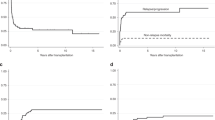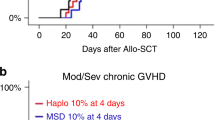Abstract
Neoplasms of natural killer (NK)-lineage are rare. Their prognosis is generally poor except for cases of solitary nasal NK-cell lymphoma. The NK-cell Tumor Study Group performed a survey in Japan on patients diagnosed between 1994 and 1998. Of 228 patients selected for analysis, 40 underwent HSCT (15 allografts and 25 autografts). The underlying diseases were myeloid/NK cell precursor acute leukemia (n=4), blastic NK-cell lymphoma (n=11), aggressive NK-cell leukemia (n=3), and nasal-type extranodal NK-cell lymphoma (n=22). At the time of HSCT, 22 patients were in complete remission (CR), 11 were in relapse, and seven were primary refractory. All patients received myeloablative conditioning regimens including total-body irradiation. Sixteen died of disease progression, and six of treatment-related causes. Overall, 4-year survival was 39% with a median follow-up of 50 months; this was significantly better than that of patients who did not undergo HSCT (21%, P=0.0003). For patients transplanted in CR, the 4-year overall survival was 68%, which was significantly better than that of patients who went into CR but did not undergo HSCT (P=0.03). These findings suggest that the HSCT is a promising treatment strategy for NK-cell lineage.
This is a preview of subscription content, access via your institution
Access options
Subscribe to this journal
Receive 12 print issues and online access
$259.00 per year
only $21.58 per issue
Buy this article
- Purchase on Springer Link
- Instant access to full article PDF
Prices may be subject to local taxes which are calculated during checkout




Similar content being viewed by others
References
Robertson MJ, Ritz J . Biology and clinical relevance of human natural killer cells. Blood 1990; 76: 2421–2438.
Cooper MA, Fehniger TA, Turner SC, Chen KS, Ghaheri BA, Ghayur T et al. Human natural killer cells: a unique innate immunoregulatory role for the CD56 bright subset. Blood 2001; 97: 3146–3151.
Farag SS, VanDeusen JB, Feninger TA, Caligiuri MA . Biology and clinical impact of human natural killer cells. Int J Hematol 2003; 78: 7–17.
Oshimi K . Leukemia and lymphoma of natural killer lineage cells. Int J Hematol 2003; 78: 18–23.
Lymphoma Study Group of Japanese Pathologists. World Health Organization classification of malignant lymphomas in Japan: Incidence of recently recognized entities. Pathol Int 2000; 50: 696–702.
Ko YH, Kim CW, Park CS, Jang HK, Lee SS, Kim SH et al. REAL classification of malignant lymphomas in the Republic of Korea: incidence of recently recognized entities and changes in clinicopathologic features. Hematolymphoreticular Study Group of the Korean Society of Pathologists. Revised European-American lymphoma. Cancer 1998; 83: 806–812.
Nakamura S, Katoh E, Koshikawa T, Yatabe Y, Nagasaka T, Ishida H et al. Clinicopathologic study of nasal T/NK-cell lymphoma among the Japanese. Pathol Int 1997; 47: 38–53.
Kwong YL, Chan ACL, Liang R, Chiang AK, Chim CS, Chan TK et al. CD56+ NK lymphomas: clinicopathological features and prognosis. Br J Haematol 1997; 97: 821–829.
Cheung MM, Chan JK, Lau WH, Foo W, Chan PT, Ng CS et al. Primary non-Hodgkin's lymphoma of the nose and nasopharynx: clinical features, tumor immunophenotype, and treatment outcome in 113 patients. J Clin Oncol 1998; 16: 70–77.
Chim C-S, Ma S-Y, Au W-Y, Choy C, Lie AK, Liang R et al. Primary nasal natural killer cell lymphoma: long-term treatment outcome and relationship with the international prognostic index. Blood 2004; 103: 216–221.
Kim GE, Cho JH, Yang WI, Chung EJ, Suh CO, Park KR et al. Angiocentric lymphoma of the head and neck: patterns of systemic failure after radiation treatment. J Clin Oncol 2000; 18: 54–63.
Kim WS, Song SY, Ahn YC, Ko YH, Baek CH, Kim DY et al. CHOP followed by involved field radiation. Is it optimal for localized nasal natural killer/T-cell lymphoma? Ann Oncol 2001; 12: 349–352.
Cheung MMC, Chan JKC, Lau W-H, Ngan RK, Foo WW . Early stage nasal NK/T-cell lymphoma: clinical outcome, prognostic factor, and the effect of treatment modality. Int J Radiat Oncol Biol Phys 2002; 54: 182–190.
Ko YH, Ree HJ, Kim WS, Choi WH, Moon WS, Kim SW . Clinicopathologic and genotypic study of extranodal nasal-type natural killer/T-cell lymphoma and natural killer precursor lymphoma among Koreans. Cancer 2000; 89: 2106–2116.
Li CC, Tien HF, Tang JL, Yao M, Chen YC, Su IJ et al. Treatment outcome and pattern of failure in 77 patients with sinonasal natural killer/T-cell or T-cell lymphoma. Cancer 2004; 100: 366–375.
Yamaguchi M, Kita K, Miwa H, Nishii K, Oka K, Ohno T et al. Frequent expression of p-glycoprotein/MDR1 by nasal T-cell lymphoma cells. Cancer 1995; 76: 2351–2356.
Egashira M, Kawamata N, Sugimoto K, Kaneko T, Oshimi K . P-glycoprotein expression on normal and abnormally expanded natural killer cells and inhibition of P-glycoprotein function by cyclosporin A and its analogue, PSC833. Blood 1999; 93: 599–606.
Suzuki R, Suzumiya J, Nakamura S, Aoki S, Notoya A, Ozaki S et al. Aggressive natural killer-cell leukemia revisited: large granular lymphocyte leukemia of cytotoxic NK cells. Leukemia 2004; 18: 763–770.
Liang R, Chen F, Lee CK, Kwong YL, Chim CS, Yau CC et al. Autologous bone marrow transplantation for primary nasal T/NK cell lymphoma. Bone Marrow Transplant 1997; 19: 91–93.
Nawa Y, Takenaka K, Shinagawa K, Deguchi S, Matsumura N, Koyama S et al. Successful treatment of advanced natural killer cell lymphoma with high-dose chemotherapy and syngeneic peripheral blood stem cell transplantation. Bone Marrow Transplant 1999; 23: 1321–1322.
Sasaki M, Matsue K, Takeuchi M, Mitome M, Hirose Y . Successful treatment of disseminated nasal NK/T-cell lymphoma using double autologous peripheral blood stem cell transplantation. Int J Hematol 2000; 71: 75–78.
Nagafuji K, Fujisaki T, Arima F, Ohshima K . L-as paraginase induced durable remission of relapsed nasal NK/T-cell lymphoma after autologous peripheral blood stem cell transplantation. Int J Hematol 2001; 74: 447–450.
Takenaka K, Shinagawa K, Maeda Y, Makita M, Kozuka T, Ashiba A et al. High-dose chemotherapy with hematopoietic stem cell transplantation is effective for nasal and nasal-type CD56+ natural killer cell lymphomas. Leuk Lymphoma 2001; 42: 1297–1303.
Sanda T, Iida S, Ito M, Tsuboi K, Miura K, Harada S et al. Successful treatment of nasal T-cell lymphoma with a combination of local irradiation and high-dose chemotherapy. Int J Hematol 2002; 75: 195–200.
Makita M, Maeda Y, Takenaka K, Shinagawa K, Sunami K, Hiramatsu Y et al. Successful treatment of progressive NK cell lymphoma with allogeneic peripheral stem cell transplantation followed by early cyclosporine tapering and donor leukocyte infusions. Int J Hematol 2002; 76: 94–97.
Au WY, Lie AK, Liang R, Kwong YL, Yau CC, Cheung MM et al. Autologous stem cell transplantation for nasal NK/T-cell lymphoma: a progress report on its value. Ann Oncol 2003; 14: 1673–1676.
Suminoe A, Matsuzaki A, Takada H, Hattori H, Furuno K, Takemoto M et al. An infant with precursor natural killer (NK) cell leukemia successfully treated with an unrelated cord blood transplantation. Leuk Lymphoma 2000; 39: 641–646.
Tezuka K, Nakayama H, Honda K, Suzumiya J, Oshima K, Kitoh T et al. Treatment of a child with myeloid/NK cell precursor acute leukemia with L-asparaginase and unrelated cord blood transplantation. Int J Hematol 2002; 75: 201–206.
Yoshimasu T, Manabe A, Tanaka R, Mochizuki S, Ebihara Y, Ishikawa K et al. Successful treatment of relapsed blastic natural killer cell lymphoma with unrelated cord blood transplantation. Bone Marrow Transplant 2002; 30: 41–44.
Hyakuna N, Toguchi S, Higa T, Okudaira T, Taira N, Masuda M et al. Childhood blastic NK cell leukemia successfully treated with L-asparaginase and allogeneic bone marrow transplantation. Pediatr Blood Cancer 2004; 42: 631–634.
Oshimi K, Kawa K, Nakamura S, Suzuki R, Suzumiya J, Yamaguchi M et al. NK-cell neoplasms in Japan. Hematology J 2005; 10: 237–245.
Suzuki R, Yamamoto K, Seto M, Kagami Y, Ogura M, Yatabe Y et al. CD7+ and CD56+ Myeloid/NK cell precursor acute leukemia: a distinct hematolymphoid disease entity. Blood 1997; 90: 2417–2428.
Suzuki R, Nakamura S . Malignancies of natural killer (NK) cell precursor: myeloid/NK cell precursor acute leukemia and blastic NK cell lymphoma/leukemia. Leuk Res 1999; 23: 615–624.
Suzuki R, Murata M, Kami M, Ohtake S, Asou N, Kodera Y et al. Prognostic significance of CD7+ CD56+ phenotype and chromosome 5 abnormalities for acute myeloid leukemia M0. Int J Hematol 2003; 77: 482–489.
Suzuki R, Nakamura S, Suzumiya J, Ichimura K, Ichikawa M, Ogata K et al. Blastic natural killer cell lymphoma/leukemia (CD56-positive blastic tumor): prognostication and categorization according to anatomic sites of involvement. Cancer 2005; 104: 1022–1031.
Chan JKC, Jaffe ES, Ralfkiaer E . Extranodal NK/T-cell lymphoma, nasal type. In: Jaffe ES, Harris NL, Stein H, Vardiman JW (eds). World Health Organization Classification of Tumours. Pathology and Genetics of Tumours of Haematopoietic and Lymphoid Tissues. IARC Press: Lyon, France, 2001, pp 204–207.
Murashige N, Kami M, Kishi Y, Kim SW, Takeuchi M, Matsue K et al. Allogeneic hematopoietic stem cell transplantation as a promising treatment for natural killer-cell neoplasms. Blood 2004; 104: 910a.
Reimer P, Rüdiger T, Kraemer D, Kunzmann V, Weissinger F, Zettl A et al. What is CD4+ CD56+ malignancy and how should it be treated? Bone Marrow Transplant 2003; 32: 637–646.
Jones RJ, Ambinder RF, Piantadosi S, Santos GW . Evidence of a graft-versus-lymphoma effect associated with allogeneic bone marrow transplantation. Blood 1991; 77: 649–653.
Sykes M, Preffer F, McAfee S, Saidman SL, Weymouth D, Andrews DM et al. Mixed lymphohaemopoietic chimerism and graft-versus-lymphoma effects after non-myeloablative therapy and HLA-mismatched bone-marrow transplantation. Lancet 1999; 353: 1755–1759.
Acknowledgements
This work was supported in part by a Grant-in-Aid for the Second-Term Comprehensive 10-year Strategy for Cancer Control from the Ministry of Health and Welfare, a Grant-in-Aid for Science on Primary Areas (Cancer Research), from the Ministry of Education, Science and Culture, Japan. The authors wish to thank the following collaborating institutions and their staffs for providing the patient data and specimens: Japanese Red Cross Asahikawa Hospital; Hokkaido University School of Medicine; National Sapporo Hospital; Sapporo Municipal Hospital; Fukushima Medical College; Ibaraki Children's Hospital; Tokyo University School of Medicine; Nippon Telephone and Telegram Kanto Hospital; Institute of Medical Science, Tokyo Women's Medical College; Metropolitan Komagome Hospital; National Cancer Center; Keio University School of Medicine; Nippon Medical School; Saiseikai Maebashi Hospital; Niigata University School of Medicine; Kanazawa University School of Medicine; Kanazawa Medical College; Mie University School of Medicine; Japanese Red Cross Kyoto First Hospital; Japanese Red Cross Osaka Hospital; Osaka Municipal Medical Center; National Osaka Hospital; Okayama University School of Medicine; Shimane Medical College; Tokushima University School of Medicine; Kurume Medical College; Kyushu University School of Medicine.
Author information
Authors and Affiliations
Consortia
Corresponding author
Rights and permissions
About this article
Cite this article
Suzuki, R., Suzumiya, J., Nakamura, S. et al. Hematopoietic stem cell transplantation for natural killer-cell lineage neoplasms. Bone Marrow Transplant 37, 425–431 (2006). https://doi.org/10.1038/sj.bmt.1705244
Received:
Revised:
Accepted:
Published:
Issue Date:
DOI: https://doi.org/10.1038/sj.bmt.1705244
Keywords
This article is cited by
-
Allogeneic hematopoietic stem cell transplantation for NK/T-cell lymphoma: an international collaborative analysis
Leukemia (2023)
-
NK/T Cell Lymphoma: Updates in Therapy
Current Hematologic Malignancy Reports (2018)
-
Oncogenic activation of JAK3-STAT signaling confers clinical sensitivity to PRN371, a novel selective and potent JAK3 inhibitor, in natural killer/T-cell lymphoma
Leukemia (2018)
-
T-cell lymphomas, a challenging disease: types, treatments, and future
International Journal of Clinical Oncology (2017)
-
Prognostic relevance of pretransplant Deauville score on PET-CT and presence of EBV DNA in patients who underwent autologous stem cell transplantation for ENKTL
Bone Marrow Transplantation (2016)



